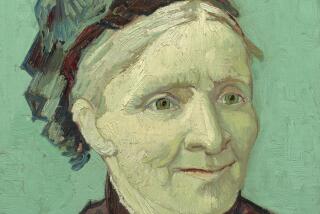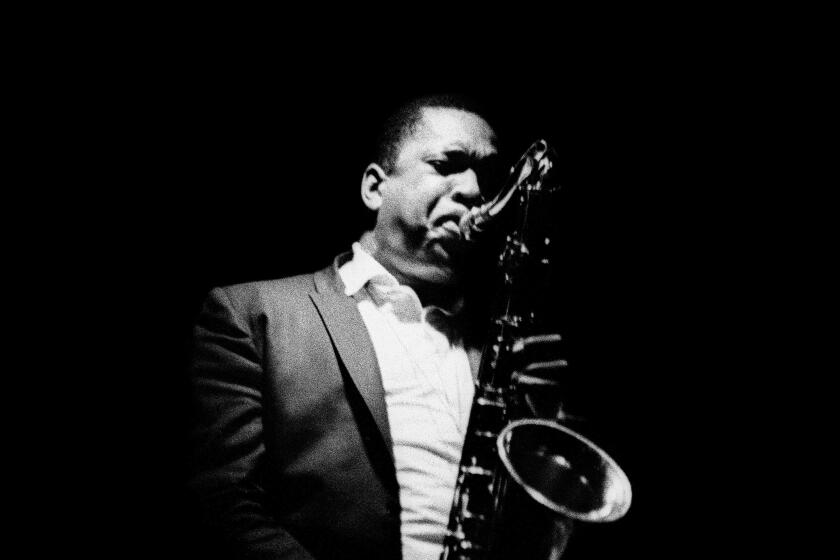Peruvian’s Art Sometimes Powerful, Sometimes Gratuitous
- Share via
LA JOLLA — Fernando de Szyszlo, Peru’s best-known painter, practices an art of fusion, melding together European and pre-Columbian motifs, abstract and figurative styles. His current show, at the Iturralde Gallery (7592 Fay Ave.) through Dec. 13, reveals his work also to be of hybrid quality, at one moment rich and suffused with mythical power, the next decorative and gratuitous.
Szyszlo, who was born in 1925, studied architecture in his native Lima before shifting his focus to art. He lived in Paris, Florence and several American cities sporadically throughout the 1950s and ‘60s, but since then has been based primarily in Peru. His work has been collected and exhibited internationally, and was recently seen at the San Diego Museum of Art in the traveling exhibition “The Latin American Spirit.”
The paintings and prints in the Iturralde show, all from the 1980s, speak in the highly personal vocabulary of forms that Szyszlo has developed over his 40-year career. Occasionally, his shapes and patterns resonate with those found in pre-Columbian art and architecture.
For instance, in each work in the series, “Mar de Lurin” (Sea of Lurin), Szyszlo sets a blocky vertical shape before a horizontally striated background. The vertical form vaguely suggests a human figure, but its articulated sections also recall ancient stele and the colossal columns of Toltec temples. While the background appears landscape-like, its undulating layers of patterns also echo the meandering geometric ornamentation of ancient Mesoamerican temples.
Szyszlo’s affinity with ancient cultures surfaces throughout his work, though subtly. In “Anabase,” a gouache painting on paper from the series, the artist pictures a flat ocher plane studded with squat, pyramidal forms. A knot of hot color and swirling shapes rushes toward these structures on the horizon with the blind fury of an impending storm. Szyszlo may be pitting the flux and fury of modern civilization against the solidity and permanence of the ancients in this powerful image, just as he may be representing the classic dichotomy between nature (the horizontal) and culture (the vertical) in his “Mar de Lurin” series.
The strongest of Szyszlo’s images sustain and even encourage such lofty interpretations, but others trade this poetic tension for trite decoration, and abandon the artist’s fiery hues and ominous shadows for a palette of lipstick pinks.
After a generation of hard-edged abstraction, minimalism and conceptualism, painting has made a comeback on the American scene. Impassioned brushwork flung itself with fervor onto gallery walls in the early ‘80s in the work of neoexpressionists, while young “new image” painters and others professing a new romanticism have breathed life into an otherwise arid artistic landscape.
For some artists, however, painting never died. Its potential to satisfy the senses and nourish the spirit never even waned during the ‘60s and ‘70s.
Geer Morton, for one, has been frosting canvases with lush, juicy pigment for 30 years, undetered by opposing winds of taste and popularity. “East Coast, West Coast,” at the Tarbox Gallery (1202 Kettner Blvd.) through Dec. 9, joins paintings from a short-term stay in San Diego with works from Maine and Northern California, where the artist maintains homes.
Morton’s work makes no intellectual claims and has no pretenses of conceptual currency. It is refreshingly free of rhetoric, relying only on rich color, genuine emotion and uncontrived gestures for its appeal. Morton’s creamy tones and abbreviated representational style owe much to his mentors of the ‘60s, Bay Area painters Richard Diebenkorn, Elmer Bischoff and David Park, but his work feels more modest in intent. He clings to traditional themes--landscapes, floral still lifes, figure studies--and seeks in earnest to capture the fleeting light and mood of each arrangement.
Morton’s fluid strokes have a natural affinity with their organic subjects, and it comes as no surprise that his paintings of cities, with their blocky, static monoliths, are the least convincing. Flowers, however, seem to continually regenerate his painterly energy, and each arrangement maintains its individuality and integrity. A dozen distinct brush strokes in a subtle range of tones define a small glass vase in “Porch With Flowers,” exemplifying the artist’s keen regard for even the most nondescript objects.
Deep ochers, teals and violets balance against shimmering whites, golds and fleshy pinks in Morton’s ceaselessly varied palette. Morton makes each canvas a celebration of the transitory moment, for he knows that color and light never meet the same way in the same place twice.
More to Read
The biggest entertainment stories
Get our big stories about Hollywood, film, television, music, arts, culture and more right in your inbox as soon as they publish.
You may occasionally receive promotional content from the Los Angeles Times.










